Canon EOS-5DBy: Dave EtchellsSlightly smaller and lighter upgrade brings greater speed and ease of use along with higher res and lower image noise. <<Video, Power, Software :(Previous) | (Next): Guest Review by Sean Reid>> Page 12:Test Results & ConclusionReview First Posted: 04/02/2006 |
We ran the Canon EOS 5D through our usual battery of tests, and have summarized our findings here. To see the full set of our test images, with explanations of what to look for in them, see the Canon EOS 5D Sample Pictures page. For a complete listing of all our test and "gallery" shots, go to the Thumbnails page.
Not sure which camera to buy? Let your eyes be the ultimate judge! Visit our Comparometer(tm) to compare images from the EOS 5D with those from other cameras you may be considering. The proof is in the pictures, so let your own eyes decide which you like best!
Lens
The EOS 5D accommodates a wide range of Canon lenses with the EF mount, so lens performance will depend entirely on the lens in use.
Sensor
Exposure and White Balance
Indoors, incandescent lighting
Strong warm cast with the Auto white balance setting, though good results with the Manual option. Less exposure compensation required than usual.
| Auto White Balance +0.7 EV | Tungsten WB +0.7 EV |
| 2800 Kelvin WB +0.7 EV | Manual WB +0.7 EV |
Color balance indoors under incandescent lighting was quite warm and orange in Auto white balance mode, though the Manual setting handled it quite well. The 5D only required a +0.7 EV exposure compensation boost to get a good exposure, much less than average for this shot. Overall color is quite good, though the blue flowers very dark and purplish, and the greens are a bit dark as well. (Many digital camera produce dark and purplish blues here however.) Our test lighting for this shot is a mixture of 60 and 100 watt household incandescent bulb, a pretty yellow light source, but a very common one in typical home settings here in the US.
Outdoors, daylight
Good color balance, very bright colors. Good exposure accuracy.
| Auto White Balance, +0.7 EV | Auto White Balance, Auto Exposure |
Outdoor shots generally showed accurate exposure with only slightly blown out highlights. The EOS 5D required less exposure compensation than average on our "Sunlit" shot (above left), but the shadowed foliage on the left side of the frame in our Far-Field shot (above left) tricked the evaluative metering system a little, causing it to overexpose the highlights in the house. Shadow detail was very good, with clean detail and relatively little evidence of lost detail due to noise suppression. Apart from the slight overexposure in the somewhat pathological image of the house above, exposure was generally quite accurate.
See full set of test images with explanations
See thumbnails of all test and gallery images
Resolution
Very high resolution, beyond 2,000 lines of strong detail.
Our laboratory resolution chart revealed sharp, distinct line patterns down well past 2,000 lines per picture height on the main resolution target. On the half-size target, detail was good to about 2,100 lines (1,050 lines on the half-size chart), with extinction at around 2,500 (1,250 on the half-size chart). Use these numbers to compare with other cameras of similar resolution, or use them to see just what higher resolution can mean in terms of potential detail. Beware that while you might be able to make out what looks like distinct lines at numbers higher than those we've mentioned here, the camera is just doing its best to continue interpreting the lines. If you zoom in and follow them from the wider portions, you'll see the lines converge and reappear several times, so the lines you see at 3,000 and higher (1,500 on the half-size target) are really only artifacts generated by the camera's imaging system.
See full set of test images with explanations
See thumbnails of all test and gallery images
Sharpness & Detail
Excellent definition and very sharp details, without strong over-sharpening from the camera.
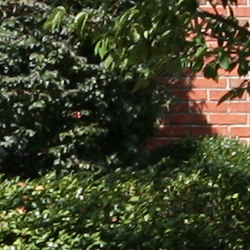 |
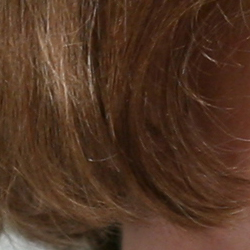 |
| Excellent definition of high-contrast elements. | Subtle detail: Hair Noise suppression tends to blur detail in areas of subtle contrast, though results are much better than average here. |
The EOS 5D's images show really excellent definition in the fine details. Some edge enhancement is visible along sharp, strongly contrasting images, but it's relatively innocuous, is largely invisible and doesn't seem to lead to loss of significant detail. (Edge enhancement creates the illusion of sharpness by enhancing colors and tones right at the edge of a rapid transition in color or tone.)
Noise-suppression systems in digital cameras tend to flatten-out detail in areas of subtle contrast. The effects can often be seen in shots of human hair, where the individual strands are lost and an almost "watercolor" look appears. The crop at far right shows this very slightly, but even the darker areas of Marti's hair show very good detail. - The EOS 5D is noticeably better than average in this regard.
ISO & Noise Performance
Low noise even at the higher sensitivity settings, though stronger noise with brighter pixels at the 1,600 and 3,200 settings.
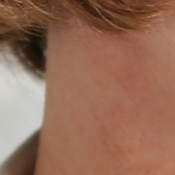 |
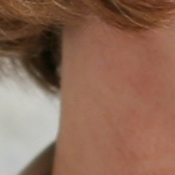 |
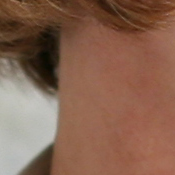 |
| ISO 50 | ISO 100 | ISO 200 |
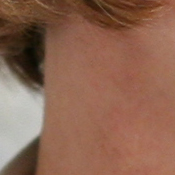 |
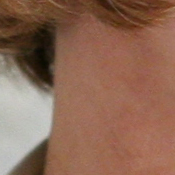 |
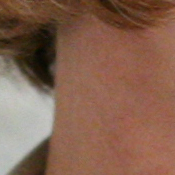 |
| ISO 400 | ISO 800 | ISO 1,600 |
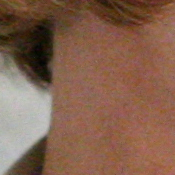 |
||
| ISO 3,200 |
The EOS 5D's performed very well with regards to image noise, producing only low to moderate noise levels even at the higher sensitivity settings. At ISOs 1,600 and 3,200, noise level definitely increases, as does blurring in the fine detail, but results are still surprisingly good, considering the high sensitivity setting. When printed, we were amazed by how good even ISO 3200 images looked, even at fairly large sizes. At 8x11, we definitely saw chroma noise when we squinted up close, but at normal viewing distances of a foot or so, the noise was all but invisible. (This will obviously be somewhat subject-dependent, of course.) ISO 1600 images would be suitable for wall display at 13x19 inches. Quite impressive!
Extremes: Sunlit and low light tests
High resolution with excellent detail. Good shadow detail and contrast as well. Excellent low-light performance, capable of capturing bright images under average city street lighting and much darker conditions.
| +0.3 EV | +0.7 EV | +1.0 EV |
Sunlight:
Because digital cameras are more like slide film than negative film (in that they tend to have a more limited tonal range), we test them in the harshest situations to see how they handle scenes with bright highlights and dark shadows, as well as what kind of sensitivity they have in low light. The shot above is designed to mimic the very harsh, contrasty effect of direct noonday sunlight, a very tough challenge for most digital cameras. (You can read details of this test here.)
The EOS 5D performed well under the deliberately harsh lighting in the test above, producing a surprisingly good tonal range when the contrast setting was dialed down in the camera's record menu. Detail was good in the bright highlights and deep shadows, with only moderate blurring from noise suppression. (In "real life" though, be sure to use fill flash in situations like the one shown above; it's better to shoot in the shade when possible.)
Low light:
The EOS 5D is very capable at low-light shooting, as we captured bright, usable images at the lowest light level of our test, at all of the ISO settings tested. Color balance turned slightly warm and pink at the lower light levels with the Auto white balance, but was very good at the brighter light levels, and better than average everywhere. The camera's autofocus system worked well, able to focus on the subject down to the darkest light levels we test at, even with its AF-assist light turned off.
The EOS 5D's noise reduction systems are particularly effective. Like Canon's other d-SLRs with CMOS sensors, the 5D produced almost no "hot pixel" noise, even at the longest exposure times (30 seconds) we used here. Its optional dark-frame subtraction noise reduction thus shouldn't be necessary for the vast majority of shooting most people will do with the camera. We did try a couple of 10-minute exposures (of the inside of a closet, so the really weren't suited to sharing here), and were amazed by how well the camera did. There were definitely hot pixels present in the shot without the optional long-exposure noise reduction enabled, but the shots with the noise reduction on were surprisingly clean. (The wait for the camera to complete the dark-frame calibration shot seemed interminable though, since it took an additional 10 minutes after the actual 10-minute exposure itself was completed, before the camera came back to us and responded to its controls again.)
As good as the EOS 5D is in the noise department though, the EOS-1Ds Mark II still reigns supreme in this area. The 1Ds Mark II's has a higher noise magnitude, but its grain pattern is unusually fine, making it much less apparent to the eye. (Read our Imatest Results page on the 5D for more details and discussion on noise and other image attributes.)
Dynamic Range
Dynamic range is simply the range of light to dark values that can be accurately represented by the camera. We usually relegate our discussion of dynamic range to the Imatest Results page for each camera (where you'll still find the full discussion of it for the Canon 5D), but are now bringing it out to the main Test Results page because of the interest it holds for many photographers, and the range of misconceptions about it that seem to be circulating in the photo community.
Any discussion of dynamic range must take into consideration the role that noise plays in separating useful dynamic range from some discernible dynamic range. As you manipulate a digital image, boosting the shadow brightness to reach deeper into the shadows to find detail, the image noise will be boosted along with the brightness of the subject itself. At some point, the amount of noise will become objectionable. This is what we consider to be the useful dynamic range of the camera in question, and it will naturally vary from photographer to photographer and from subject to subject. For high-quality imagery though, most photographers find that noise levels somewhere between a quarter and a tenth of an f-stop generally mark the end of useful dynamic range. You may certainly be able to see image detail deeper into the shadows, but the noise levels there begin to compete seriously with the subject matter for your attention.
Recognizing the above, we display dynamic range numbers (obtained from Imatest) for noise thresholds ranging from a full f-stop to 1/10 f-stop, but rank cameras in order of their dynamic range at the most conservative, 1/10-stop noise threshold. (That said though, as we've pointed out for some time now, noise amplitude is only part of the story, the frequency or "grain size" of the noise often having a greater effect on how noticeable it is. Lacking a good heuristic for correlating noise frequency content with image quality though, we're unfortunately reduced to considering only noise amplitude in our dynamic range measurements.)
With the above as background, here are the results we obtained in our dynamic range tests of the EOS 5D. To begin, the graph below shows the test results from Imatest for the EOS 5D with a nominally-exposed density step target (Stouffer 4110), using the 5D's "Standard" Picture Style.
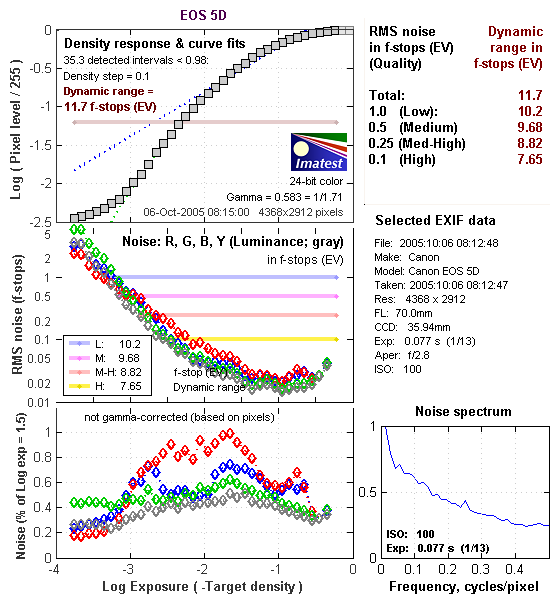
These are excellent numbers, particularly coming straight from the camera as a JPEG. What I especially like about the above data though is the very nice "S" shape to the density curve. The Canon 5D's tonal response looks very much like film in this respect, with a nice gentle tail at each end of its tone curve. On a practical basis, this means that both highlights and shadows tend to trail off gracefully, with no hard clipping or obvious tone breaks in what should be smooth tonal gradations.
Let's also look though, at how the EOS 5D's images behave when processed from the RAW format:

The plots above show the results of a somewhat more overexposed frame, shot to give the RAW processing software more overexposed density steps on the highlight end to play with. These steps show in the associated JPEG file as completely blown out to white, but cameras often have a little headroom for highlights in their RAW files that some RAW processing software can pull back. In contrast, the camera itself seemed to do about 0.2 stops better when the lightest step was just shy of blowing out.) The results above were obtained after processing a CR2 RAW file through Digital Photo Professional 2.0, and tweaking the controls to produce a final image that just barely revealed all the image data shown in the DPP histogram displays within the available tonal range.
Interestingly, DPP doesn't extract quite as much dynamic range from the CR2 file as the camera itself manages in the JPEG. In particular, no highlight detail appeared that wasn't already present in the original JPEG, no matter how I contorted the tone curve in DPP.
What's interesting about the above data though, is the Noise Spectrum plot in the lower right. Compare it to the same plot in the results for the camera JPEG above. See how high and relatively flat it is on the right-hand side? That's because the image noise in the DPP sample is much finer-grained than that from the camera itself. We'll look into that a bit further down.
What about Adobe Camera Raw (ACR) though?
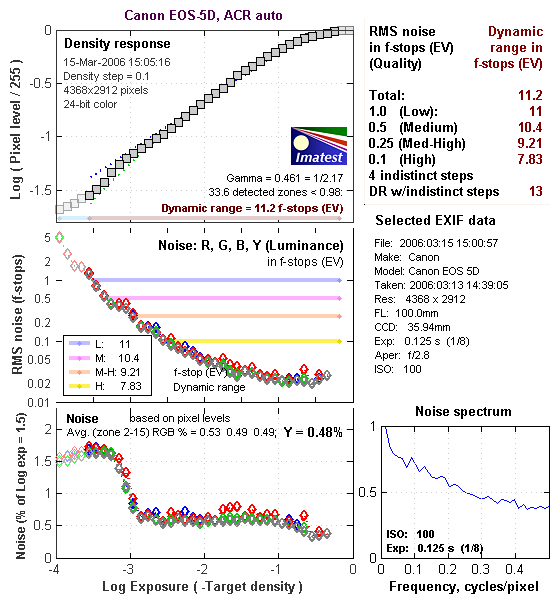
Using its automatic settings (which in my experience have generally worked best for dynamic range tests like this), ACR managed to extract about a third of a stop more dynamic range from the CR2 file at the highest quality level, but did quite well when indistinct steps in the greyscale were considered. In particular, it managed to recover upwards of a full stop more detail in highlights that were totally blown out in the Camera JPEG or DPP-derived image. I played a bit with the controls in Adobe Camera Raw, but no setting did much better than ACR did on its own. (I managed to get a bit smoother tone curve, and a bit more detail revealed in the shadows, but at the cost of a little of the data in the highlights.) Here again though, the Noise Spectrum plot reveals that the noise from ACR is a bit finer-grained than in JPEGs straight from the camera.
Let's take a look at some crops from the test images, to see what the noise patterns look like from the three sources (camera, ACR, DPP):
| From Camera | From ACR | From DPP |
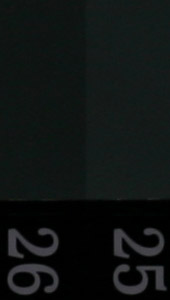 |
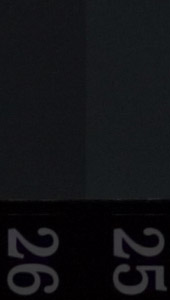 |
 |
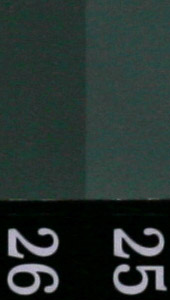 |
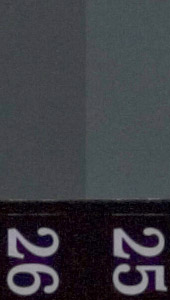 |
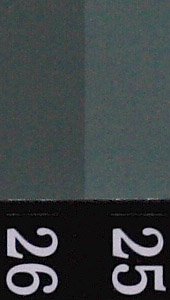 |
| (Same shots as above, but brightened in Photoshop with the Levels tool, setting the highlight slider to 100) | ||
The images above show crops from the original camera JPEG, a version processed through ACR, and the one processed through DPP. What's particularly interesting is that ACR does a better job at its default noise-reduction settings of "flattening" the noise in the individual color channels than either the camera or DPP, but the image is a bit softer with the default sharpness settings. Chroma noise is considerably reduced, and the noise pattern is finer-grained than that produced by the camera, but coarser than that from DPP. DPP's noise is a bit finer-grained than that from the camera's own JPEGs, but there's arguably a bit more chroma noise, and the grain of the chroma component also seems coarser than in either of the other samples. Also interesting is that the default settings of both ACR and DPP produced more neutral grey scales than did the camera.
To get some perspective, here's a summary of the EOS 5D's dynamic range performance, and how it compares to other digital SLRs that we also have Imatest dynamic range data for. (Results are arranged in order of decreasing dynamic range at the "High" quality level.):
| Dynamic Range (in f-stops) vs Image Quality (At camera's minimum ISO) |
||||
| Model | 1.0 (Low) |
0.5 (Medium) |
0.25 (Med-High) |
0.1 (High) |
| Fujifilm S3 Pro (Adobe Camera Raw 2) |
12.1 | 11.7 | 10.7 | 9.0 |
| Canon EOS-1Ds Mark II (Adobe Camera Raw 3) |
11.2 | 10.3 | 9.4 | 8.14 |
| Fujifilm S3 Pro | -- | 9.9 | 9.4 | 7.94 |
| Canon EOS 5D (Adobe Camera Raw 3) |
11.0 | 10.4 | 9.21 | 7.83 |
| Canon EOS 5D (Camera JPEG) |
10.2 | 9.68 | 8.82 | 7.65 |
| Nikon D200 (Adobe Camera Raw 3) |
10.6 | 9.65 | 8.96 | 7.61 |
| Nikon D50 | 10.7 | 9.93 | 8.70 | 7.36 |
| Canon EOS 20D | 10.3 | 9.66 | 8.85 | 7.29 |
| Canon Digital Rebel XT | 10.3 | 9.51 | 8.61 | 7.11 |
| Nikon D200 (Camera JPEG) |
-- | 9.07 | 8.36 | 7.11 |
| Olympus EVOLT E-300 | 10.8 | 9.26 | 8.48 | 7.07 |
| Canon EOS-1Ds Mark II (Camera JPEG) |
10.3 | 9.38 | 8.6 | 7.04 |
| Canon Digital Rebel | 10.1 | 9.11 | 8.47 | 6.97 |
| Pentax *istDs | 10.2 | 10 | 8.87 | 6.9 |
| Nikon D2x | -- | 8.93 | 7.75 | 6.43 |
| Nikon D70S | 9.84 | 8.69 | 7.46 | 5.85 |
| Nikon D70 | 9.81 | 8.76 | 7.58 | 5.84 |
The results shown in the table are interesting. One of the first things that struck me when I initially looked at test data for a number of d-SLRs, was that here again, purely analytical measurements don't correlate 100% with actual photographic experience. There's no question that the Fuji S3 Pro deserves its place atop the list, as its unique "SR" technology does indeed deliver a very obvious improvement in tonal range, especially in the highlight portion of the tonal scale. I was surprised to see the analytical results place the Olympus EVOLT E-300 as highly as they did, given that our sense of that camera's images was that they were in fact noisier than those of many other d-SLRs that we've tested. In the other direction, I was quite surprised to see the Nikon D2x place as low on the listings as it did, given that we found that camera's shadow detail to be little short of amazing.
One thing that's going on here though, is that we tested each camera at its lowest ISO setting, which should produce best-case noise levels. This is in fact what many photographers will be most interested in, but it does perhaps place the Nikons at a disadvantage, as their lowest ISO setting is 200, as compared to the ISO 100 settings available on most other models.
Regardless of the positions of the other cameras though, it's clear from its images that the EOS 5D's noise levels are quite low, helped by its relatively large pixels, Canon's advanced CMOS sensor technology, and artful anti-noise processing in its Digic II processor.
As I always say though, at the end of the day, I think you have to take purely analytical tests of this sort with a grain of salt, and look at actual images with your own eyes to see what you make of each camera's tonal range and noise levels. We'll continue performing these dynamic range tests on the digital SLRs that we review, but (just as with the laboratory resolution target results), we suggest that you not rely on them exclusively for making your purchase decisions.
Color
Saturation & Hue Accuracy
Very good overall color and hue accuracy, though a slight tendency toward darker color. Still, excellent results.
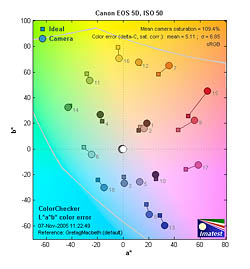 |
| In the diagram above, the squares show the original color, and the circles show the color that the camera captured. More saturated colors are located towards the periphery of the graph. Hue changes as you travel around the center. Thus, hue-accurate, highly saturated colors appear as lines radiating from the center. |
Most consumer digital cameras produce color that's more highly saturated (more intense) than found in the original subjects. This is simply because most people like their color a bit brighter than life. The Canon EOS 5D showed good color accuracy overall, but tended to get pretty carried away with strong reds. This is a fairly common response with this target (the MacBeth ColorChecker), but the 5D falls toward the upper end of the range of oversaturation of reds that we've seen in professional SLRs.
The other important part of color rendition is hue accuracy. Hue is "what color" the color is. Here, the EOS 5D also did quite well, with hue accuracy among the best we've seen though, there being only slight shifts in cyans, magentas, and oranges. Average saturation was 108.5% (oversaturated by 8.5%, almost entirely in the reds), average "delta-E" color error was 4.98. (Hue error, after correction for saturation, among the best we've seen.)
(Read our Imatest Results page on the 5D for more details and discussion on color rendering and other image attributes.)
Viewfinder
Coverage
A slightly tight optical viewfinder, but still good results.
| Optical viewfinder |
The EOS 5D's digital SLR optical viewfinder was just a little tight, showing about 96% frame accuracy. I generally expect digital SLRs to be as close to 100% accuracy as possible, so felt that the 5D fell a little short here.
Flash
The EOS 5D does not have a built-in flash, though it does offer an external flash hot-shoe and PC sync terminal. Flash results will depend entirely on the power and coverage of the external flash unit, so the camera itself has no flash performance to report on.
Output Quality
Print Quality
Exceptional print quality, accurate color, great prints to 13x19 and beyond. ISO 1600 and 3200 images are surprisingly usable at large print sizes.
Testing hundreds of digital cameras, we've found that you can only tell just so much about a camera's image quality by viewing its images on-screen. Ultimately, there's no substitute for printing a lot of images and examining them closely. For this reason, we now routinely print sample images from the cameras we test on our Canon i9900 studio printer, and on the Canon iP5200 here in the office. (See the Canon i9900 review for details on that model.)
As you'd expect from a high-resolution, full-frame camera, images from the EOS 5D made excellent prints at the 13x19 inch limit of our i9900 studio printer, and would be quite usable for wall display even at much larger sizes. Large prints straight from the camera looked a bit sharper than those from the 1Ds Mark II, because the 5D applies a bit more in-camera sharpening by default than does the 1Ds Mark II.
As noted earlier, we were particularly impressed by how well the 5D's high-ISO images did when printed at relatively large sizes. ISO 1600 images showed some visible chroma noise when viewed up close, but at typical viewing distances of a foot or more, we were hard-pressed to see any noise at all. The same was true of ISO 3200 shots viewed as 8x10 inch prints. Chroma noise was very evident in these samples when squinted at up close, but was hard to make out from a foot or so away. The EOS 5D is a camera that's very usable at ISO 1600, and even at ISO 3200 for medium-size prints with no cropping.
In terms of color, prints from the EOS 5D on our i9900 printer looked bright and vibrant without appearing overdone, but strong reds did oversaturate and lose shape and detail somewhat.
All in all, a really fine performance, everything you'd expect from a dSLR in the 5D's price category.
Timing and Performance
Canon EOS 5D Timing (Summary)
Good speed for a full-frame SLR.
| Startup/Shutdown: | |
| Power On to first shot | ~0.1 second |
| Shutter response (Lag Time): | |
Full Autofocus (100mm f/2.8 EF macro) |
0.149 second |
Manual Focus |
0.133 second |
Prefocused |
0.078 second |
| Cycle time (shot to shot) | |
| Normal large/fine JPEG | 0.4 second (25-60 shots before slowing) |
| Continuous mode | 0.33 second (3 frames/sec) 98 JPEGs, 17 RAW, 13 RAW+JPEG before slowing) |
| Download speed | |
| Windows Computer, USB 2.0 | 1,216 KBytes/sec |
(Summary only, see the Power & Timing section of this review for full details.)
For a camera with such a high-resolution image sensor, the Canon EOS 5D is surprisingly sprightly. Its 3 frame/second continuous-mode speed is good if not exciting, but it can maintain that rate for anywhere from 25-60 large/fine JPEG frames (depending strongly on subject content and ISO speed), or 17 RAW-mode shots. The Canon EOS 5D did pretty well in terms of shutter lag, being able to determine focus with the 100mm f/2.8 Canon macro lens in just 0.149 second. (AF speed is of course highly dependent on the lens being used, and the amount of travel required of the optics to move from the previous focus point.) Prefocused, the camera delivered a very fast 78 millisecond shutter lag, impressive in light of the large mirror it needs to move out of the way before the shot can be captured. We don't test for it explicitly, but the viewfinder blackout in continuous mode did seem to be a bit on the long side, enough so that we found it a little distracting.
Battery Life
Battery
Short battery life with the LCD on, very good when LCD is switched off.
| Capture mode, 20C/68F | 800 shots |
| Capture mode, 0C/32F | 400 shots |
he EOS 5D uses the same BP-511A battery introduced with the Canon PowerShot Pro1, and which now appears as standard in many of Canon's cameras. These are compatible with older chargers and cameras, they're just of higher capacity. The BP-511A battery pack provides 1390 mAh at 7.4 volts. A separate charger comes in the box with the 5D. It works much like many of the recent ELPH chargers, with two flip-out prongs that plug directly into the wall. You'll need to purchase the AC adapter kit ACK-E2 if you need to run the camera from AC power. Canon's optional BG-E4 battery grip permits the use of either two BP-511A or six AA-size batteries.
Because it lacks an external power terminal, I couldn't perform my usual direct measurements of power consumption on the EOS 5D. I can attest to its excellent battery life though, as I should shoot literally for days without exhausting a fully-charged battery. Canon rates battery life at 800 shots, at 20 degrees C / 68 degrees F, or 400 shots at 0 degrees C / 32 degrees F which certainly seem like reasonable ratings given my personal experience with the camera.
Conclusion
| Pro: | Con: |
|---|---|
|
|
Following in the impressive footsteps laid down by earlier members of the highly-acclaimed Canon EOS line of digital SLRs, the new 5D definitely upholds its EOS lineage. While a truly excellent photographic tool though, it doesn't automatically represent a slam-dunk choice between it and a sub-frame camera -- or even between it and the much more expensive EOS-1Ds Mark II. The 5D struck us as an odd mixture of consumer and professional aesthetics, a slightly uncomfortable fit in the current world of d-SLRs. For people addicted to ultrawide angle photography with a substantial investment in full-frame wide angle lenses, it will probably be a no-brainer. But for someone not already invested in wide-angle glass, you could buy an EOS 30D and Canon's excellent little 10-22mm EF-S wide-angle lens and have more than just change to spare relative to the cost of the 5D body alone. Not only that, but the 10-22mm's performance on a 30D will be superior to that of most ultrawide full-frame lenses on the 5D. After only a little shooting with it, it became manifestly clear that this was a camera that absolutely shows up every minute flaw in a lens' performance, particularly in the corners of the frame. The sub-frame cameras also have the advantage of being markedly faster than the 5D in continuous mode, in part a consequence of the larger mirror that the 5D needs to flap back and forth between shots.
On the upper end of the scale, the massive EOS-1Ds Mark II does have some advantages relative to the 5D, namely a more rugged construction, a more long-lived shutter, perceptibly better resolution, and noticeably better noise characteristics. (The 1Ds Mark II shows higher noise amplitude, but finer "grain" structure, making it less objectionable overall.) It might be hard to argue that these advantages justify the $4,000+ price increment between the 5D and 1Ds Mark II, but if you're looking for the ultimate full-frame experience (with price no object), the 1Ds Mark II is still the way to go.
On the other hand, full-frame purists with more modest budgets or unwilling to lug around the daunting weight of a 1Ds Mark II will find an awful lot to like in the 5D. It's also a more approachable camera for the casual shooter, thanks to its Picture Styles (think of them as film types, one more suited to portraits, one more suited to landscape shots, etc) and slightly more aggressive in-camera sharpening. The bottom line is that the 5D is a better camera if you really want to use JPEGs from the camera as the final file format (without processing after the fact on a computer). Also, while we've been speaking glibly of "full-frame purists," shooters only just now making the move from traditional film-based SLRs may find that the 5D offers a much more comfortable transition than would a sub-frame model. We encountered the opposite side of this in shooting with the 5D, as we found ourselves having to really re-think framing and focal lengths after our long immersion in the sub-frame world. Moving from a film SLR to the 5D would be a relatively painless change, as all your lenses would behave exactly the same as they did on your film body. (Except you'd now see all their flaws magnified and splashed across your computer screen.)
If you're not a die-hard full-frame fan though, a Canon EOS 5D may not be the best choice for you. A 30D with the Canon EF-S 10-22mm wide-angle zoom and a good-quality intermediate zoom would actually be a more powerful picture-taking machine, and likely one costing a lot less than the 5D body alone.
We expect to see Canon continue their evolution of full-frame d-SLRs, and also work more on their L-glass lenses to bring lens performance into line with the demands of full-frame digital sensors. Our guess is that this will ultimately be the way a lot of the SLR market will go, at least in the fullness of time. For now though, it's our opinion that sub-frame digital SLRs offer a better cost/performance ratio.
In addition to all the test results and analysis, we did notice something intangible in the images coming from the Canon EOS 5D. Others have mentioned it too: greater detail in the shadows, and a finer tonal range that give the images a special glow that you don't get from a 20D or 30D. We do notice a difference in the tonal curves on the 5D, which might account for the unique flavor 5D images seem to have.
For the record, we highly recommend the Canon EOS 5D as a full-frame d-SLR option, but do counsel readers to consider their sub-frame options carefully before taking the plunge with a 5D.
Reader Comments! --> Visit our discussion forum for the Canon EOS-5D!
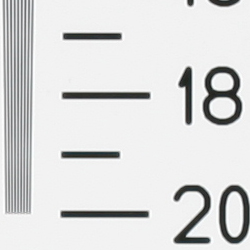
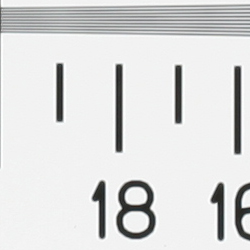
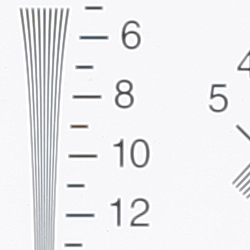
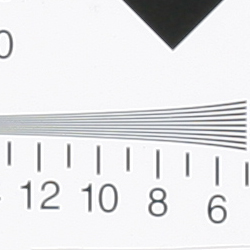

Follow Imaging Resource: